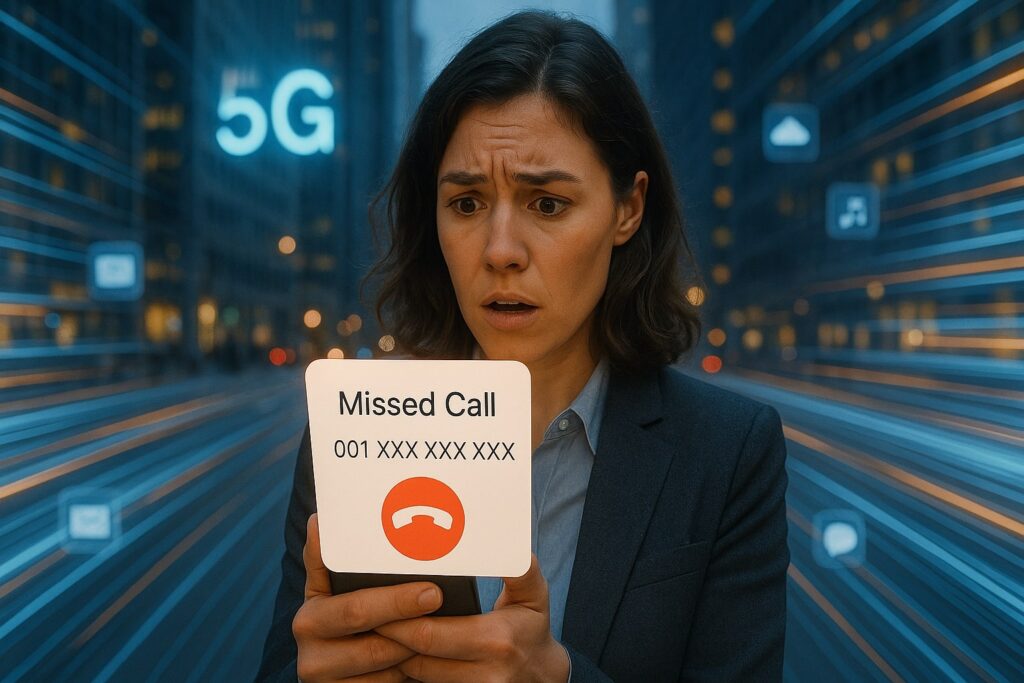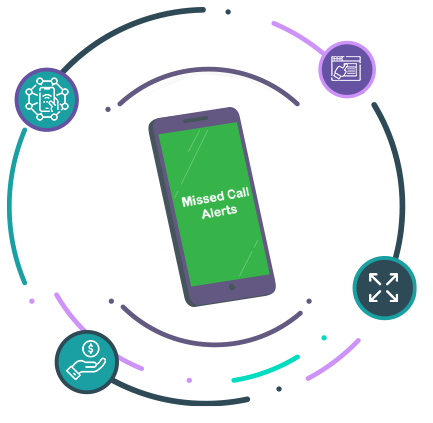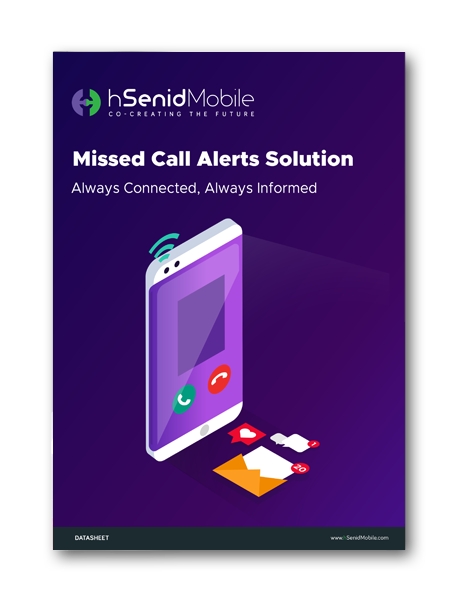We live in an era of real-time messaging, smart notifications, and ultra-fast connectivity. With 5G technology rolling out across the globe, it’s easy to assume that traditional voice-based features like call alerts are on their way out. But surprisingly, one simple service continues to hold its ground, even in this hyper-connected world—the missed call alert.
Often considered a legacy service, missed call alerts are quietly proving their relevance in the 5G age. They provide a simple but powerful way to maintain communication, ensure business continuity, and enhance user experience, especially when connectivity fails or users are temporarily unreachable.
So why do missed calls still matter? And how can telcos and businesses leverage this humble feature in a modern communications landscape? Let’s dive in.
That’s where a missed call alert becomes invaluable. It bridges the gap between the caller’s intent and the recipient’s availability, notifying users when someone tried to reach them—even if their phone was off, unreachable, or out of network coverage.
Whether it’s a customer trying to reach a support center, a delivery agent calling a buyer, or a friend checking in during a signal drop, knowing that someone tried to call is a simple but vital piece of information.
In a 5G-driven world where communication channels are multiplying, the MCA brings clarity and continuity when voice fails to connect in real time.
These challenges can be addressed with modern messaging infrastructure, intelligent routing engines, and cloud-based delivery systems.
While the future of telecom is being shaped by AI, 5G, and cloud-native systems, this humble feature continues to prove its worth by quietly supporting billions of meaningful interactions.
To learn how to implement or modernize your missed call alert service for 5G environments, visit our website and explore hSenid Mobile’s powerful solutions for next-generation telecom infrastructure.
Often considered a legacy service, missed call alerts are quietly proving their relevance in the 5G age. They provide a simple but powerful way to maintain communication, ensure business continuity, and enhance user experience, especially when connectivity fails or users are temporarily unreachable.
So why do missed calls still matter? And how can telcos and businesses leverage this humble feature in a modern communications landscape? Let’s dive in.
The Missed Call: Still a Critical Communication Trigger
Despite the availability of messaging apps and social platforms, voice calls remain a preferred communication method for many people. Calls are personal, immediate, and often the fastest way to resolve something important. But with busy schedules, dropped connections, and mobile devices switching off or going out of range, calls get missed every day.That’s where a missed call alert becomes invaluable. It bridges the gap between the caller’s intent and the recipient’s availability, notifying users when someone tried to reach them—even if their phone was off, unreachable, or out of network coverage.
Whether it’s a customer trying to reach a support center, a delivery agent calling a buyer, or a friend checking in during a signal drop, knowing that someone tried to call is a simple but vital piece of information.
Why Missed Call Alerts Still Matter in the 5G Era
5G has promised many things—lower latency, higher speeds, and more connected devices. But no technology can guarantee 100% availability at all times. Here’s why missed call services remain relevant, even with the most advanced networks:- Network Gaps Still Exist
5G is powerful, but its rollout is uneven. Rural areas, underground zones, and indoor environments may still lack consistent coverage. Even in urban spaces, switching between towers or traveling can lead to signal drops. MCA helps users stay informed, no matter where they are. It ensures that when coverage returns, they’re notified about any communication they may have missed. - Battery and Device Failures
Even the best smartphones run out of battery, crash unexpectedly, or go into airplane mode during travel. Missed call alerts work as a backup notification, keeping communication reliable even when the device is temporarily offline. - Roaming and International Travel
International users or roaming subscribers often face unpredictable connectivity, especially when switching between networks. Missed call alerts act as a lifeline for travelers, keeping them informed even when they miss incoming calls due to coverage or cost-related call rejections. - Voice Remains King in Emergencies
In moments of urgency, people still pick up the phone and call. Whether it’s a family emergency, a business-critical conversation, or a time-sensitive update, knowing that someone called—even if the call wasn’t answered—matters.
In a 5G-driven world where communication channels are multiplying, the MCA brings clarity and continuity when voice fails to connect in real time.
Business Use Cases: Where Simplicity Drives Results
- Customer Experience and Loyalty
For customer-facing businesses, showing customers that their call attempt was recognized—even if it couldn’t be answered, improves trust. A follow-up callback or SMS can help recover lost engagement and show that the business cares. - Lead Generation in Emerging Markets
In many regions, missed calls are used as a cost-free way for users to express interest in a product or service. Telcos can enable businesses to use missed calls as a lead capture mechanism, where customers simply dial a number and hang up to receive a response or offer. - Support and Service Centers
When customer support lines are busy or unavailable, a MCA service can help identify customers who tried to connect. This allows for follow-up and reduces customer frustration. - Telecom Value-Added Services (VAS)
For mobile operators, the MCA remains a popular VAS offering, especially for prepaid customers. It’s lightweight, easy to enable, and can be bundled with other call-related services like voicemail, call hold, or number masking.
How Modern Missed Call Alerts Have Evolved
MCAs today are more intelligent and flexible than ever before. Thanks to cloud-native architectures and modern telecom platforms, they can be:- Real-time and event-driven: Alerts can be sent via SMS, push notification, or in-app messages, depending on user preference.
- Multilingual and localized: Messages can be customized based on region, language, or service tier.
- Integrated with CRM and analytics: Enterprises can track missed call patterns, response rates, and user preferences for better engagement.
- Customizable by users: Advanced features allow users to opt in or out, set preferred alert channels, or request automated callbacks.
Challenges and Considerations
While MCA services are incredibly useful, there are a few things telecoms and businesses should consider:- User Consent and Spam Control: Ensure users opt in to receive alerts, and avoid triggering notifications for spam or robocalls.
- Integration with VoIP and OTT platforms: As voice moves to the internet, missed call logic should integrate with app-based call tracking too.
- Performance Under Load: Alerts should be delivered instantly, even during high-traffic periods, requiring scalable platforms and smart routing.
These challenges can be addressed with modern messaging infrastructure, intelligent routing engines, and cloud-based delivery systems.
Conclusion: Simple, Effective, Still Essential
In a world where communication is more complex than ever, the MCA remains a reminder that simple tools still hold tremendous value. It ensures people stay connected, businesses don’t lose leads, and networks deliver on reliability even when devices or signals fail.While the future of telecom is being shaped by AI, 5G, and cloud-native systems, this humble feature continues to prove its worth by quietly supporting billions of meaningful interactions.
To learn how to implement or modernize your missed call alert service for 5G environments, visit our website and explore hSenid Mobile’s powerful solutions for next-generation telecom infrastructure.








